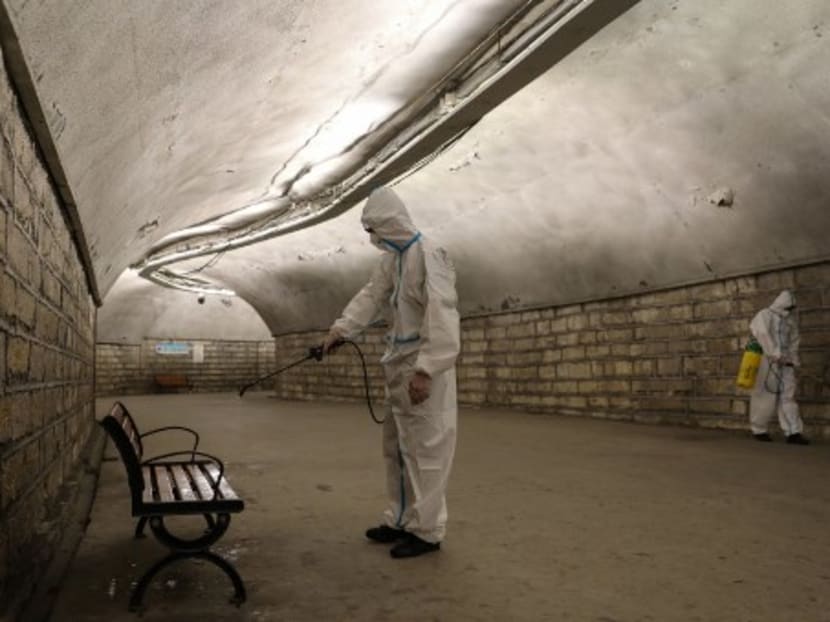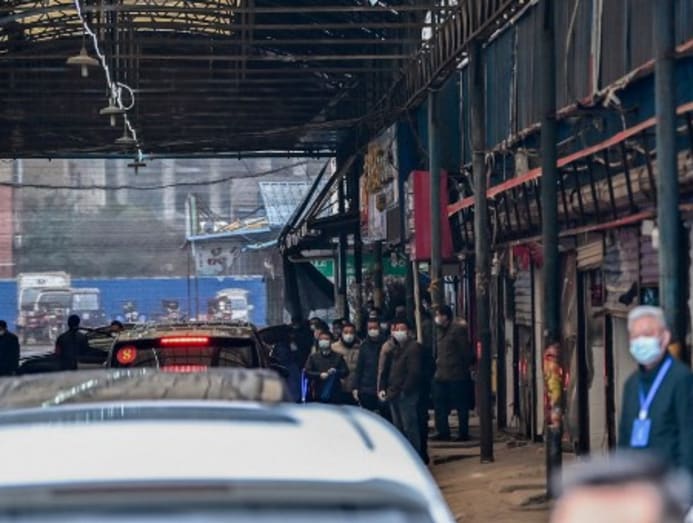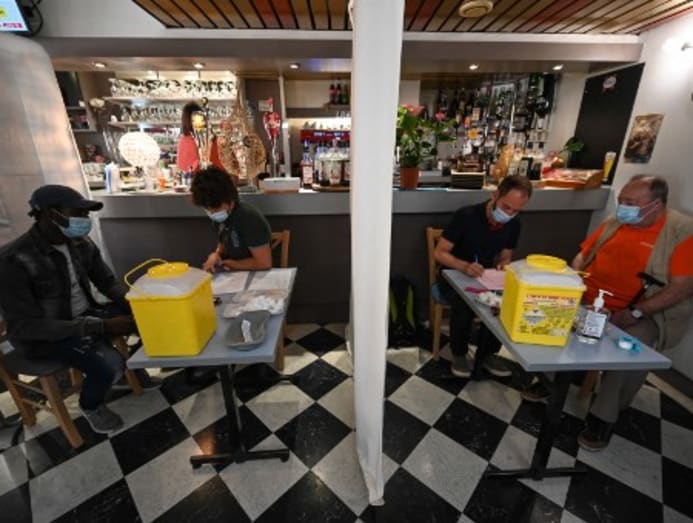Here's what the future holds for the coronavirus and us
Advertisement
Wellness
Here's what the future holds for the coronavirus and the states
We lost the beginning few rounds, by assuasive the virus to spread unchecked, but we still accept powerful weapons to bring to the fight.

This photograph taken on Octo 6, 2022 shows a staff member spraying disinfectant at Gulangyu Island as the island prepares to reopen to tourists after existence closed due to the outbreak of the COVID-19 coronavirus, in Xiamen in China's eastern Fujian province. (Photo: AFP/STR)
On Jan ix, 2020, nearly a week afterward the earth first learned of a mysterious cluster of pneumonia cases in central China, authorities appear that scientists had found the culprit: A novel coronavirus.
It was a sobering annunciation and an unnervingly familiar one. Nearly two decades earlier, a different coronavirus had hurdled over the species barrier and sped effectually the world, causing a lethal new disease chosen severe acute respiratory syndrome, or SARS. The virus, which became known as SARS-CoV, killed 774 people before health officials contained it.
Just even as scientists worried that history might exist repeating itself, there was one blink of hope. Although all viruses evolve, coronaviruses are known to be relatively stable, irresolute more slowly than the common flu.
"There was, I think, a sense that would work in our favour and that the nightmare scenario of it existence like influenza – constantly changing and needing updated vaccines all the time – would probably not be the instance," said Dr Adam Lauring, a virus expert and infectious disease physician at the University of Michigan.

What many scientists had not counted on was unchecked global spread. During the following weeks, the new virus, SARS-CoV-two, skipped from Wuhan, China, to a cruise ship in Nippon, a small town in northern Italy and a biotechnology conference in Boston. Country by country, global coronavirus trackers turned red.
To date, more than 237 million people have been infected with the virus, and 4.viii meg have died – 700,000 in the Usa alone.
With every infection come new opportunities for the virus to mutate. Now, almost ii years into the pandemic, we are working our way through an alphabet of new viral variants: fast-spreading blastoff, immune-evading beta, and on through gamma, delta, lambda and, well-nigh recently, mu.
"We merely take uncontrolled infections in much of the world, and that'south going to lead to more chances for the virus to evolve," Lauring said.
Even for a virus, evolution is a long game, and our relationship with SARS-CoV-2 is even so in its infancy. We are extremely unlikely to eradicate the virus, scientists say, and what the side by side few years – and decades – concur is difficult to predict.
Only the legacy of past epidemics, also as some bones biological principles, provides clues to where we could be headed.
THE GENETIC LOTTERY
Viruses are replication machines, hijacking our cells to make copies of their own genomes. Sometimes they make small mistakes, akin to typos, equally they replicate.
Most of the time, these errors have no benefit for the virus; many are harmful and quickly disappear. Simply occasionally, a virus hits the genetic lottery: A mutation that confers an advantage. This fitter version of the virus tin can then outcompete its peers, giving ascent to a new variant.
The coronavirus could shift in endless ways, only there are three concerning possibilities: Information technology could become more transmissible, it could get meliorate at evading our immune organisation, or it could become more than virulent, causing more serious disease.
SARS-CoV-2 has already become more than transmissible. "The virus is just meliorate at transmitting from one person to another than information technology was in Jan of 2020," said Jesse Bloom, an expert in viral evolution at the Fred Hutchinson Cancer Enquiry Centre in Seattle. "And this is due to a variety of mutations that the virus has acquired, some of which we empathise, and some of which we don't."
One of the showtime of these mutations had already emerged by late January 2020. The mutation, D614G, nearly likely stabilised the spike protein that the virus uses to latch onto human cells, making the virus more infectious. It chop-chop became widespread, displacing the original version of the virus.
Every bit the virus spread, more than mutations sprang up, giving rise to fifty-fifty more transmissible variants. Kickoff came Alpha, which was about 50 per cent more than infectious than the original virus, and presently Delta, which was, in plough, roughly fifty per cent more infectious than Blastoff.
"Now nosotros're basically in a Delta pandemic," said Robert Garry, a virus expert at Tulane Academy. "And then another surge, some other spread of a slightly amend variant."
Although some experts were surprised to see the hyperinfectious variant, which has more than a dozen notable mutations, emerge so quickly, the appearance of more transmissible variants is textbook viral evolution.
"Information technology'south difficult to imagine that the virus is going to popular into a new species perfectly formed for that species," said Andrew Read, an evolutionary microbiologist at Penn State University. "It'southward bound to do some adaptation."
Just scientists don't expect this procedure to continue forever.
At that place are probable to be some basic biological limits on merely how infectious a particular virus can become, based on its intrinsic backdrop. Viruses that are well adapted to humans, such every bit measles and the seasonal influenza, are not constantly condign more than infectious, Blossom noted.
It is not entirely clear what the constraints on transmissibility are, he added, but at the very least, the new coronavirus cannot replicate infinitely fast or travel infinitely far.
"Transmission requires one person to somehow exhale or cough or breathe out the virus, and information technology to land in someone else'south airway and infect them," Bloom said. "There are merely limits to that procedure. It'south never going to be the case that I'thousand sitting here in my role, and I'm giving it to someone on the other side of Seattle, right?"
He added: "Whether the Delta variant is already at that plateau, or whether at that place'south going to exist further increases before it gets to that plateau, I can't say. Just I exercise call up that plateau exists."
DODGING IMMUNITY
In addition to condign more transmissible, some variants have also acquired the ability to dodge some of our antibodies. Antibodies, which can prevent the virus from entering our cells, are engineered to latch onto specific molecules on the surface of the virus, snapping into place like puzzle pieces. But genetic mutations in the virus tin can change the shape of those binding sites.
"If you modify that shape, you lot can make information technology impossible for an antibiotic to practice its job," said Marion Pepper, an immunologist at the Academy of Washington School of Medicine.
Delta appears to evade some antibodies, but there are other variants, particularly Beta, that are even better at dodging these defenses. For now, Delta is so infectious that it has managed to outcompete, and thus limit the spread of, these stealthier variants.
Just as more people acquire antibodies against the virus, mutations that permit the virus to slip past these antibodies will become even more advantageous. "The landscape of selection has changed," said Jessica Metcalf, an evolutionary biologist at Princeton University. "From the bespeak of view of the virus, information technology's no longer, 'I simply bop around, and there'due south a free host.' "
The practiced news is that there are many different kinds of antibodies, and a variant with a few new mutations is unlikely to escape them all, experts said.
"The immune organisation has besides evolved to have enough of tricks up its sleeve to annul the evolution of the virus," Pepper said. "Knowing that there is this complex level of diverseness in the immune organization allows me to sleep ameliorate at night."
Sure T cells, for instance, destroy virus-infected cells, helping to reduce the severity of disease. Together, our assortment of T cells can recognize at least 30 to 40 different pieces of SARS-CoV-two, researchers accept found.
"Information technology's a lot harder to evade T prison cell responses than antibody responses," said Dr Celine Gounder, an communicable diseases specialist at the New York University Grossman Schoolhouse of Medicine.
And and then there are B cells, which generate our army of antibodies. Even after we clear the infection, the body keeps churning out B cells for a while, deliberately introducing small genetic mutations. The event is an enormously diverse collection of B cells producing an assortment of antibodies, some of which might be a skilful match for the adjacent variant that comes along.
"They're actually a library of guesses that the immune arrangement makes about what variants might expect similar in the time to come," said Shane Crotty, a virus expert at the La Jolla Institute for Immunology.
So far, studies suggest that our antibody, T prison cell and B cell responses are all working equally expected when it comes to SARS-CoV-2. "This virus is mostly playing by immunological rules we understand," Crotty said.
"NO INTEREST IN KILLING Usa"
Whether the virus will become more virulent – that is, whether it volition crusade more serious disease – is the hardest to predict, scientists said. Unlike transmissibility or allowed evasion, virulence has no inherent evolutionary advantage.
"The virus has no involvement in killing usa," Metcalf said. "Virulence but matters for the virus if it works for transmission."
Because people who are hospitalised may be less likely to spread the virus than those who are walking around with the sniffles, some have theorised that new viruses go milder over time.
One commonly cited example is the myxoma virus, which Australian scientists released in 1950 in an attempt to reduce the population of invasive European rabbits.
Initially, the myxoma virus proved to be "fantastically virulent", one scientist wrote, killing more than 99 per cent of the rabbits it infected. After just a few years, however, several somewhat milder strains of the virus emerged and became ascendant.
But myxoma is non a elementary story of a virus gradually becoming less virulent.
"Early variants that were too squeamish were as well discovered in the mid-1950s," said Read, who has studied the virus. "They caused little disease simply transmitted poorly, so never came to dominate."
The rabbits too evolved new immune defenses that allowed them to fight off infection more hands, and then the virus fired dorsum, acquiring new tricks for depressing the rabbits' immune systems.
"Seventy years – information technology's still going gangbusters," Read said.

Information technology is besides early to say whether SARS-CoV-ii will modify in virulence over the long term. In that location could certainly exist trade-offs between virulence and transmission; variants that brand people too sick too chop-chop may non spread very far.
Then again, this virus spreads before people become severely ill. As long as that remains true, the virus could become more virulent without sacrificing transmissibility.
Moreover, the same thing that makes the virus more infectious – faster replication or tighter binding to our cells – could also make information technology more virulent. Indeed, some evidence suggests that Delta is more likely to issue in hospitalisation than other variants.
"I could actually go on this game of imagining going on for a long time," Read said. "On my proficient days, I'm optimistic that the illness severity will go down through fourth dimension. Considering clearly, people beingness isolated does affect transmission. On my bad days, I worry about information technology going the other direction."
UNEASY EQUILIBRIUM
Although many possible paths remain open to u.s.a., what is certain is that SARS-CoV-two will not end evolving – and that the arms race between the virus and us is just first.
Nosotros lost the starting time few rounds, past allowing the virus to spread unchecked, simply we still have powerful weapons to bring to the fight. The about notable are highly effective vaccines, developed at record speed. "I think there is hope in the fact that the SARS-CoV-ii vaccines at this point are more than effective than flu vaccines have probably ever been," Bloom said.
Even the start-generation vaccines provide substantial protection against illness, and there is plenty of room to meliorate them by tinkering with the dosing and timing, tailoring them to new variants or developing new approaches, such every bit nasal sprays, that may be better at halting transmission.
"I have great faith that we can sort whatsoever detrimental evolutionary trajectories out by improving our current or next generation vaccines," Read said.
The occasional breakthrough infection or booster could help peak up our flagging immunity and teach our bodies to recognize new mutations, ultimately making united states less vulnerable to the adjacent variant that comes along.
"Maybe you have a reinfection, but it'southward relatively mild, which also boosts your amnesty," Gounder said.
Meanwhile, as the number of completely vulnerable hosts dwindles, and transmission slows, the virus volition have fewer opportunities to mutate. I recent paper, which has not yet been reviewed by experts, suggests that rise vaccination rates may already be suppressing new mutations.
And the development rate could besides slow down equally the virus becomes ameliorate adapted to humans.
"At that place's low-hanging fruit," Lauring said. "So there are certain ways information technology tin evolve and make large improvements, but later on a while there aren't areas to improve – it's figured out all the like shooting fish in a barrel ways to amend."
Eventually, as viral development slows downwardly and our immune systems grab upwards, nosotros will reach an uneasy equilibrium with the virus, scientists predict. We will never extinguish it, just it will smolder rather than rage.
What that equilibrium point looks like exactly – how much transmission there is and how much disease information technology causes – is uncertain. Some scientists predict that the virus will ultimately be much similar the flu, which tin can even so cause serious illness and expiry, peculiarly during seasonal surges.
Others are more optimistic. "My guess is that one twenty-four hour period this is going to be another crusade of the common cold," said Jennie Lavine, who explored that possibility equally an infectious illness researcher at Emory University.
There are four other coronaviruses that take become owned in human populations. We are exposed to them early and often, and all four mostly cause run-of-the-mill colds.
COVID-19 might just be what it looks like when a novel coronavirus spreads through a population without whatsoever preexisting immunity. "This may non be such a unlike fauna than everything else that we're accustomed to," Lavine said. "It'south but a bad moment."
Of course, plenty of uncertainties remain, scientists said, including how long it will take to reach equilibrium. With infections beginning to decline again in the Usa, hopes are over again rising that the worst of the pandemic is behind usa.
But much of the world remains unvaccinated, and this virus has already proved capable of surprising us. "Nosotros should be somewhat cautious and humble about trying to predict what it is capable of doing in the time to come," Crotty said.
While we can't guard against every eventuality, we can tip the odds in our favor by expanding viral surveillance, speeding upwards global vaccine distribution and tamping downwardly transmission until more than people can be vaccinated, scientists said.
The actions nosotros take now will help decide what the coming years expect similar, said Dr Jonathan Quick, a global health skilful at Knuckles University and the author of The End of Epidemics.
The future, he said, "depends much, much more on what humans do than on what the virus does".
Past Emily Anthes © The New York Times
This article originally appeared in The New York Times.
Source: New York Times/hs
Contempo Searches
Trending Topics
Source: https://cnalifestyle.channelnewsasia.com/wellness/coronavirus-covid19-what-future-holds-284561

0 Response to "Here's what the future holds for the coronavirus and us"
Post a Comment